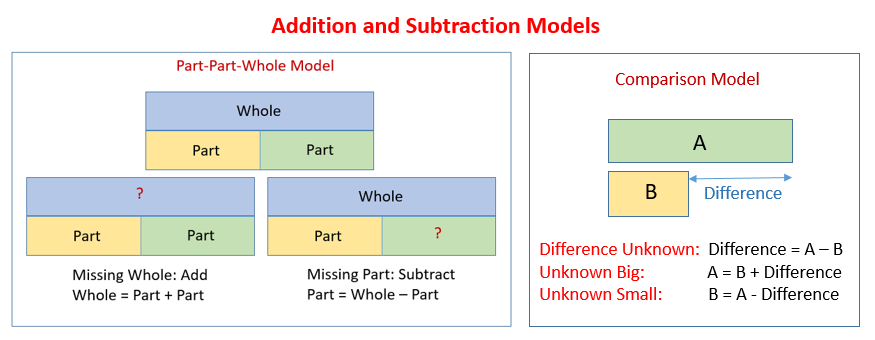Addition & Subtraction Word Problems
The following diagrams shows how the Part-part-whole Model and Comparison model can be used for addition and subtraction word problems. Scroll down the page for examples and solutions.

How to solve addition and subtraction two-step word problems?
These examples of addition and subtraction word problems and solutions will illustrate how to use the block diagrams (Singapore Math) method and tape diagrams (Common Core Math) to solve word problems.
Go to Math Word Problems for more examples.
How to use bar models to solve addition and subtraction word problems?
Examples:
- The Toyota car factory makes 7,736 cars a day. It makes 1,372 more cars a day than the Honda car factory.
a) How many cars does the Honda factory make each day?
b) If the Honda factory sells 3,459 cars today, how many cars will the Honda factory have left?
- A high school has 4,268 students. It has 768 less students than the college.
a) How many students does the college have?
b) How many students do both schools have altogether?
- The Chicago tribune, a newspaper, prints 483 papers on Tuesday. The newspaper prints 87 fewer newspapers on Thursday.
a) How many newspapers does the paper print on Thursday?
b) How many papers does the Chicago Tribune print on both Tuesday and Thursday?
What is a Tape Diagram?
A tape diagram is a drawing that looks like a segment of tape, used to illustrate number relationships. It is also known as strip diagrams, bar model, fraction strip, or length model.
How to use tape diagrams in Part-whole Model and Additive Comparison Model problems?
Examples:
- The office supply closet had 25,473 large paperclips, 13,648 medium paperclips and 15,306 small paperclips. How many paperclips were in the closet?
- Raffle tickets were sold for a school fundraiser to parent, teachers, and students. 563 tickets were sold to teachers. 888 mire tickets were sold to students than to teachers. 904 tickets were sold to parents.
a) About how many tickets were sold to parents, teachers, and students? Round each number to the nearest hundred to find your estimate.
b) Exactly how many tickets were sold to parents, teachers, and students?
c) Assess the reasonableness of your answer in (b). Use your estimate from (a) to explain.
- During the month of March 68,025 pounds of king crab were caught. If 15,614 pounds were caught in the first week of March, how many pounds were caught in the rest of the month?
How to model and solve an addition or subtraction word problem involving two changes?
Example:
Danny has 40 Star Fleet cards. He lost 17 cards at the park. He bought 13 cards at the store. How many cards did Danny have then?
How to model and solve a part-whole addition word problem involving two parts
Singapore Math - Addition and Subtraction with Two Parts
Part-Whole Model with two parts - Finding the whole.
Example:
Dylan paid $5 for a book. He had $19 left. How much money did Dylan have at first?
How to model and solve a part-whole addition word problem involving three parts?
Singapore Math - Addition and Subtraction with Three Parts
Example:
Sam is reading a book. He read 9 pages yesterday and 5 pages today. If he reads 12 more pages, he will finish the book. How many pages are in Sam’s book?
Try the free Mathway calculator and
problem solver below to practice various math topics. Try the given examples, or type in your own
problem and check your answer with the step-by-step explanations.

We welcome your feedback, comments and questions about this site or page. Please submit your feedback or enquiries via our Feedback page.